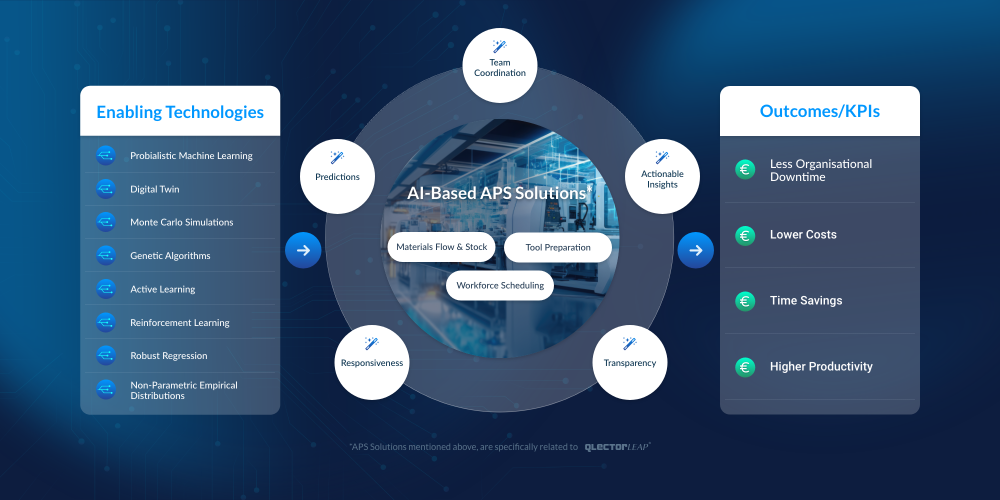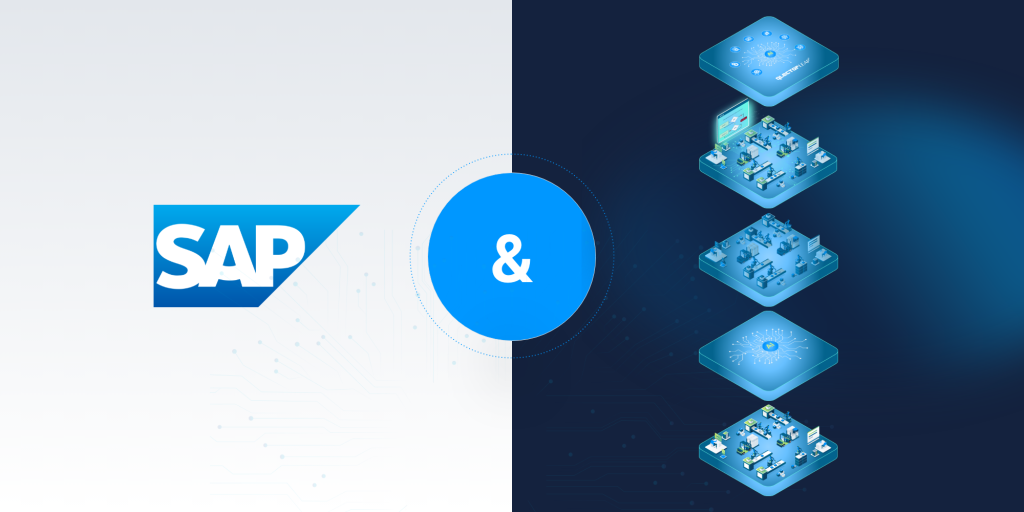Downtime is one of the most expensive and stubborn challenges in modern manufacturing. But unlike traditional methods for production planning and scheduling, new industrial AI-based solutions are not fighting it with guesswork.
By leveraging Machine Learning and Digital Twin technologies through advanced planning and scheduling (APS) systems, manufacturers are now able to simulate thousands of scenarios, anticipate disruptions, and act faster than ever before. Solutions like Qlector Leap are bringing this transformation to life, offering tools built for today’s production complexity and uncertainty.
Why Downtime Is Everyone’s Problem
The scale of the issue is staggering. In automotive manufacturing, the cost of one hour of unplanned downtime has doubled since 2019 and now exceeds $2.3 million. Energy price spikes, labor shortages, and volatile supply chains only add to the pressure. Globally, the world’s 500 largest companies lose nearly $1.4 trillion annually due to unplanned downtime – that’s 11% of their total revenue.
Industrial AI has emerged as a powerful counterforce. Half of manufacturers now use at least one AI-driven solution, up from just 25% in 2019. Clearly, companies are no longer waiting for systems to fail before they act.
What Causes Downtime?
On the surface, downtime often looks like bad luck. But under the hood, it’s frequently caused by predictable shop floor dynamics:
• Inventory imbalances and delayed material supply
• Labor issues such as unexpected absences or skill mismatches
• Tool preparation and machine availability problems
This is where AI-based APS tools, such as Qlector Leap, make a real difference. They pull in ERP and MES data to deliver a continuously updated picture of operations. By comparing ERP norms to real-time production metrics, these systems flag anomalies, learn from ongoing outcomes, and refine planning logic on the fly.
In workforce scheduling, for example, AI can construct a digital twin of every worker, taking into account their availability, limitations, skills, experience level, and productivity. This ensures optimal staffing and shift planning, dramatically reducing human-induced downtime.
Unlike traditional APS solutions that depend on static ERP norms, Qlector Leap uses historical and real-time data to uncover the early signs of issues – whether it’s a stockout, an upcoming absence, or a delay on the line. With this insight, planners can act before problems become disruptions.
Key Technologies That Help Prevent Downtime
These eight technologies form the core of modern AI-based APS systems, empowering manufacturers to detect, prevent, and respond to disruptions before they cause downtime. This explanation is based on the work and expertise of the team behind Qlector Leap, who developed and implemented these capabilities in real manufacturing environments.
1. Probabilistic Machine Learning: Recognizing Patterns That Lead to Downtime
Probabilistic machine learning enables accurate forecasting in manufacturing, even when data is incomplete or highly variable.
Instead of relying on a single “most likely” outcome, probabilistic models assess multiple possible scenarios and their likelihood. For instance, the time needed to complete an order is influenced by many factors – such as machine availability, material supply fluctuations, or worker experience. Probabilistic models incorporate all these uncertainties to help planners make better-informed decisions.
By recognizing patterns that typically lead to bottlenecks or downtime, these models enable the system to anticipate and mitigate risks before they occur.
2. Digital Twin: Detecting and Predicting Potential Disruptions
A digital twin is a real-time, virtual representation of all production processes on the shop floor. Continuously updated with real-world data, it provides a dynamic “smart map” of manufacturing operations – capturing material flows, tool changes, workforce schedules, and machine statuses.
One of its key strengths lies in detecting and predicting potential disruptions or downtime. By combining historical insights with live process signals, the system can identify issues such as imbalanced workloads, critical material shortages, or delays due to inefficient tool changeovers. Through simulation, the digital twin also enables companies to evaluate the impact of such disruptions in advance and take proactive measures to optimize flow and minimize downtime.
3. Monte Carlo Simulations: Repeated Calculations Using Random Sampling
Monte Carlo simulations are a method where the system performs repeated calculations using random sampling to generate realistic scenarios that support decision-making.
In manufacturing, these simulations help answer questions such as: “What’s the probability that this order will be completed on time?” By modeling thousands of possible outcomes—considering machine breakdowns, supply delays, or variations in worker efficiency— AI-based APS systems can provide planners with a clear view of potential risks and uncertainties.
This enables early identification of process bottlenecks and supports the testing of various strategies to resolve issues before they occur.
4. Genetic Algorithms: Inspired by natural evolution
Inspired by natural evolution, genetic algorithms are used to find optimal solutions through iterative improvement.
In manufacturing, they are often applied to schedule optimization – such as the best way to allocate machines and workers to reduce downtime and improve throughput. Rather than testing every possible combination, the system uses a “survival of the fittest” approach to generate and refine increasingly effective production plans.
Genetic algorithms help eliminate organizational downtime by optimizing resource allocation and identifying the most efficient configurations of production processes.
5. Active Learning: Enhancing Models Through Human Expertise
Active learning is an approach where AI systems actively involve human experts to improve prediction accuracy—especially in unfamiliar or exceptional situations.
In manufacturing, this means the system doesn’t just passively analyze data—it also learns from operator feedback. For example, when the system proposes a schedule change, operators can validate its feasibility, helping the model adjust based on real-world human expertise.
This interaction helps identify organizational challenges that automated models alone may overlook, and supports continuous improvement through human-machine collaboration.
6. Reinforcement Learning: A Trial-and-Error Approach for Smoother Operations
Reinforcement learning works through trial and error, continuously adjusting to new conditions to improve outcomes.
Just like a person learning to ride a bike, the system learns which actions lead to the best results. In production planning, this means continuously monitoring the manufacturing process, suggesting improvements, and refining its strategies based on feedback.
By detecting bottlenecks and experimenting with corrective actions, reinforcement learning contributes to the ongoing improvement of manufacturing efficiency.
7. Robust Regression: Trustworthy Planning Despite Imperfect Data
Robust regression is a modeling technique designed to learn from data even when that data includes extreme values or errors. In manufacturing environments, this is critical – data may be affected by faulty sensors, incorrect entries, or rare operational events. Rather than allowing these anomalies to distort predictions, robust regression identifies and downweights their influence.
This increases the reliability of planning and scheduling systems, particularly in complex, noisy, or nonlinear production conditions.
By ensuring that rare or erroneous data points do not mislead the model, robust regression enables more stable, trustworthy decision-making.
8. Non-Parametric Empirical Distributions: Turning Variability into Predictive Power
Traditional modeling approaches often assume data follows a known shape, like a normal (bell-curve) distribution. But in real-world manufacturing, data often behaves differently.
Non-parametric empirical distributions allow models to learn directly from historical data without imposing assumptions on the data’s shape. This enables them to capture complex, real-life patterns – such as multimodal distributions or long-tailed behavior.
By working with realistic distributions, AI-based APS systems can make more accurate predictions and more effectively detect anomalies, predict downtime, and identify potential bottlenecks in production.
The shift is Happening Today
The shift toward AI-enhanced production planning is no longer theoretical. It’s happening today – quietly but profoundly changing how manufacturers approach downtime. Tools like Qlector Leap give planners and managers not just data, but foresight. And in modern manufacturing, foresight is everything.
Learn More with Qlector Team
Want to learn more about how Qlector Leap uses these technologies to support production planners?
Book your 20-minute introductory consultation below.












